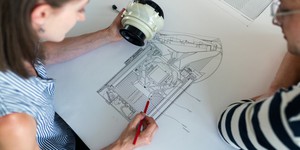The Trick to Beating a Carnival Game
Summary
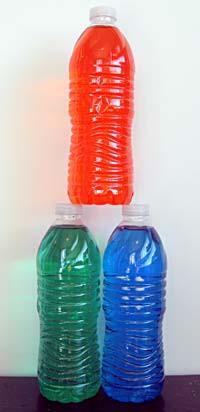 Image Credit: Teisha Rowland, Science Buddies / Science Buddies
Image Credit: Teisha Rowland, Science Buddies / Science Buddies
Introduction
Have you ever played a game at a carnival, trying to win a stuffed animal or other prize? It might look easy, until you try it. Why are those "simple" games at the fairs and carnivals so hard? Is it really lack of skill or coordination or do those concessionaires use some basic laws of science to help them set up the games in their favor? In this science activity, you will investigate how physics can help you win — or lose — at the classic game of trying to knock over a pyramid of milk bottles using a ball.Materials
- Masking tape, a stick, a rock, or a similar object to mark off a throwing distance
- Tennis ball or baseball
- Plastic bottles filled with water, all of the same shape and size (3). Make sure that you can stably stack the bottles in a pyramid shape. Most 16.9 fl. oz. drinking water bottles should work well for this.
- A very large room, or an area outside, with plenty of space so you can throw a ball without injuring someone or breaking something
- A small, stable table
- Optional: Food coloring
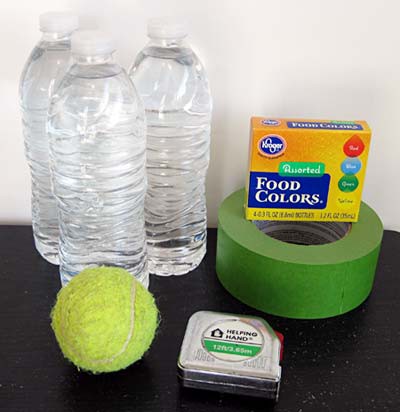 Image Credit: Teisha Rowland, Science Buddies / Science Buddies
Image Credit: Teisha Rowland, Science Buddies / Science Buddies
Instructions
- If you want, you can remove the labels from your bottles and add some food coloring (three drops) to each bottle to give your carnival game some color. If you add food coloring to the bottles, make sure you do your testing outside where it will not be a problem if a bottle spills some dyed water!
- Put the small table at a set distance from your "throw line." You might try about eight feet. Mark the throw line using a piece of masking tape, a rock, a stick or a similar object.
- Stack the three bottles into a stable pyramid shape on the table, with two bottles on the bottom and one on top, centered between them and resting on their lids. Make sure the lids are on tight. How stable is your pyramid?
 Image Credit: Teisha Rowland, Science Buddies / Science Buddies
Image Credit: Teisha Rowland, Science Buddies / Science Buddies
- From your throw line, throw the tennis ball (or baseball) at the bottle pyramid.Which bottle was hit? How many bottles were knocked over?
- Arrange the pyramid as it was before on the table.
- Repeat this process until you have hit the pyramid at least ten times with the ball. Try to throw the ball the same way each time, and try to hit each bottle a few times. How many bottles usually get knocked over? Does it seem to depend on which bottle you hit with the ball? If so, which bottle(s) do you need to hit to knock over the most bottles?
- Now take the top bottle from the pyramid and empty the water out of it. Stack the bottles into a stable pyramid shape on the table with the empty bottle on the top. How stable does this pyramid seem?
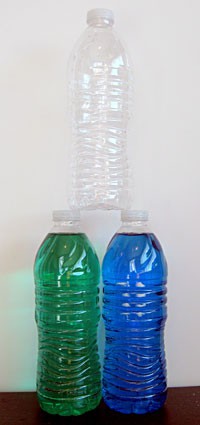 Image Credit: Teisha Rowland, Science Buddies / Science Buddies
Image Credit: Teisha Rowland, Science Buddies / Science Buddies
- As you did before, throw the ball from the throw line at the pyramid at least ten times, rearranging the pyramid on the table after each throw. Again try to throw the ball the same way each time, and try to hit each bottle a few times. How many bottles usually get knocked over now? Does hitting a certain bottle (or bottles) tend to knock over the most bottles?
- Lastly, take one of the bottom bottles from the pyramid and empty the water out of it. Stack the bottles into a stable pyramid shape on the table with the two empty bottles on the bottom and the water-filled bottle on the top.How stable does this pyramid seem?
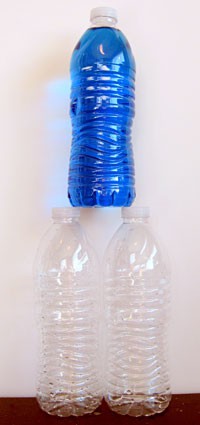 Image Credit: Teisha Rowland, Science Buddies / Science Buddies
Image Credit: Teisha Rowland, Science Buddies / Science Buddies
- As you did before, throw the ball from the throw line at the pyramid at least ten times, rearranging the pyramid on the table after each throw. Again try to throw the ball the same way each time, and try to hit each bottle a few times. How many bottles usually get knocked over with this pyramid arrangement? Does hitting a certain bottle (or bottles) tend to knock over the most bottles?
- Overall, which pyramid arrangement led to the highest number of throws where all three bottles were knocked over? In other words, which arrangement was most successful? Which was least successful?Given what you learned, how do you think this carnival game is usually arranged? Where should you aim to win the game?
What Happened?
You should have found that the third pyramid was the easiest one to knock over and was the most unstable, likely having all three bottles fall over when the ball touched any of them. The second pyramid was likely the hardest to knock completely over. In general, hitting the lower area between the bottom bottles (below the center of mass of the pyramid) should have been the most successful approach for knocking down the entire pyramid.
What changes in all these configuration is the location of the pyramid's center of mass. The center of mass is a single point that can be used to describe where the average mass is for an object (or set of objects like this pyramid). In the case of these pyramids, when all three bottles are full (as in the first pyramid) you might have thought that the center of mass was in the space between all three bottles — but it isn't. The fact that you have two full bottles on the bottom and only one on top, pulls the average placement of the pyramid's mass down closer to the center of the two bottom bottles. The center of mass for the second pyramid is even lower because there is even less mass in the top bottle. In contrast, the third pyramid has a much higher center of mass because only the top bottle is full. To knock down the pyramid completely you need to hit at or below the center of mass with a good amount of force. This is what will win you the giant stuffed animal prize at the carnival!
Digging Deeper
Locating and adjusting the center of mass is critical in balancing and stabilizing anything — not just carnival games. In general, the closer the center of mass is to the ground, the more stable a structure is. This explains why it was hardest to knock over pyramid number two — it had the lowest center of mass.
Look around you. Can you see other things that change behaviors depending on their center of mass? How about a see-saw? An empty see-saw has a center of mass that is right in the center of the see-saw. If two people of approximately equal weight sit on it then it remains balanced and the riders can easily go up and down. That changes if a second person climbs on one side though. Now there is more weight at one end, shifting the center of mass closer to the side that has two people. The see-saw no longer balances. To get it to balance again you either need to add more weight to the lighter side or have the person on the lighter end scoot closer to the middle of the see-saw. Both of these actions put the center of mass back at the middle of the see-saw and allow the riders to go back to their up and down play.
Ask an Expert
For Further Exploration
- You could repeat this activity but this time you could quantify your results. In other words, when testing each pyramid arrangement, write down which bottle is hit each time and how many bottles are knocked over. If you quantify your results, just how much more "successful" is one pyramid arrangement compared to another? How much better is it to hit one bottle compared to another?
- Try moving the throw line closer to the pyramid or further away from it. How does your throwing distance from the pyramid change how successful you are at knocking it over?
- Instead of bottles you could use wooden blocks and arrange them in different configurations, such as stacking all three on top of each other. Using wooden blocks, which configuration is easiest to knock over? Which is hardest?





